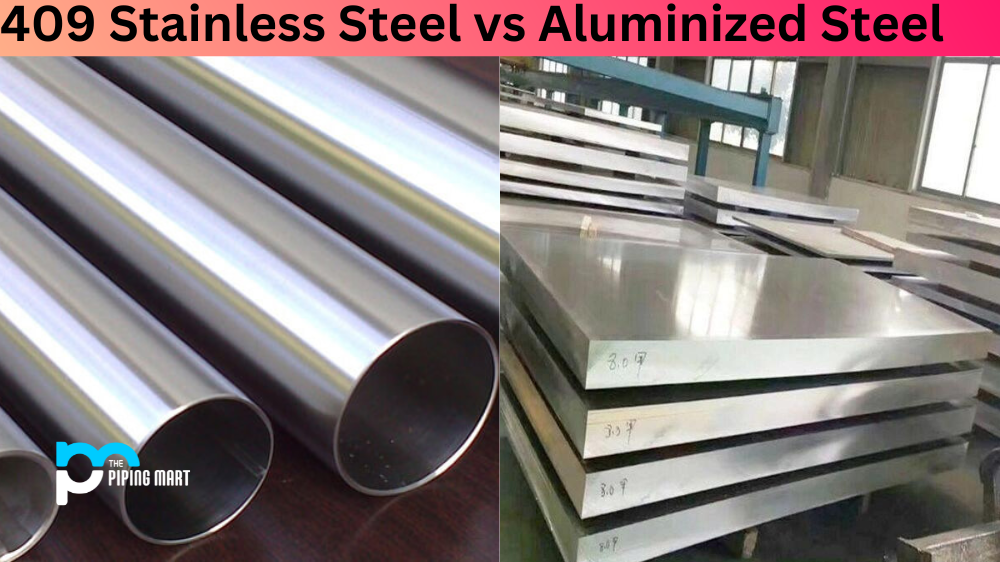When it comes to durability, strength, and reliability, there are two materials that stand out from the rest: 409 stainless steel and aluminized steel. Both materials have their own advantages and disadvantages, so it’s important to know the differences between them before making a decision. Here is an overview of the pros and cons of 409 stainless steel versus aluminized steel.
409 Stainless Steel
One of the main advantages of using 409 stainless steel is that it has excellent corrosion resistance. It is resistant to most chemicals, which makes it ideal for applications in harsh environments. This also means that it can withstand high temperatures without losing its strength or becoming brittle. Additionally, 409 stainless steel has a relatively low cost compared to other types of stainless steel, making it a great option for budget-conscious projects.
However, one disadvantage of using 409 stainless steel is that it does not offer as much flexibility as some other types of metals due to its low ductility. Additionally, this type of metal tends to be less durable than other types of metals due to its lower hardness level on the Mohs scale (it’s rated at 4).
Aluminized Steel
Aluminized steel offers good corrosion resistance and is known for being lightweight yet strong. It also offers good thermal conductivity, which makes it ideal for applications where heat needs to be moved quickly and efficiently throughout a system. Additionally, aluminized steel is relatively inexpensive compared to other types of metals, such as aluminium or copper alloys.
The main disadvantage of aluminized steel is that it has poor formability due to its stiffness and lack of ductility. Additionally, this type of metal has limited weldability due to its high carbon content; therefore, welding operations require special precautions when using this type of metal alloy. Furthermore, aluminized steel does not offer as much corrosion resistance as other types, such as galvannealed or galvanized steels, because the zinc layer on those metals provides additional protection against corrosion in addition to their inherent properties like higher strength or cost savings.
Difference Between 409 Stainless Steel and Aluminized Steel
Chemical Composition
The first difference between 409 stainless steel and aluminized steel is the chemical composition. Aluminized steel is made by coating carbon steel with an aluminium-silicon alloy. This alloy provides corrosion resistance and better heat resistance than pure aluminium. 409 stainless steel, on the other hand, is made of iron, chromium, manganese, silicon, titanium, aluminum, and nitrogen.
Heat Resistance
One of the most important differences between 409 stainless steel and aluminized steel is heat resistance. Aluminized steel can withstand temperatures up to 1200 degrees Fahrenheit without suffering any damage. 409 stainless steel, on the other hand, begins to suffer surface damage at around 650 degrees Fahrenheit.
Cost
Another difference between 409 stainless steel and aluminized steel is the cost. Aluminized steel is typically more expensive than 409 stainless steel because it is more difficult to produce. Additionally, aluminized steel often has a shorter lifespan than 409 stainless steel due to its lower heat resistance.
Applications
Aluminized steel is often used in exhaust systems because it can withstand high temperatures without being damaged. 409 stainless steel is also used in exhaust systems but is less common because it does not have as high of heat resistance. Additionally, 409 stainless steel is often used in food processing equipment because it does not corrode easily.
Weldability
Aluminized steel can be welded using any standard welding process. However, care must be taken to avoid damaging the aluminum coating.409 stainless steel can also be welded using any standard welding process but is more difficult to weld than aluminized steel because it tends to form cracks when heated
Conclusion:
When deciding between 409 stainless steel and aluminized steel for your project or application, consider both their pros and cons in order to make an informed decision about which material will best suit your needs. The ultimate decision should come down to what kind of environment your project will operate in (corrosion resistance), how much weight you need the material to carry (aluminium offers greater strength), what kind of formability you need (stainless offers better formability), and any welding requirements (aluminum requires special precautions). By considering all these factors carefully, you can make the right choice for your project!

Abhishek is a seasoned blogger and industry expert, sharing his insights and knowledge on various topics. With his research, Abhishek offers valuable insights and tips for professionals and enthusiasts. Follow him for expert advice on the latest trends and developments in the metal industry.




